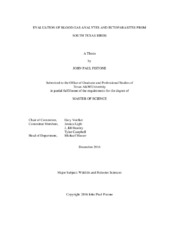| dc.description.abstract | The handheld point of care analyzer is a quick and feasible option to obtain hematology data from individuals. The iSTAT-1 was used to evaluate select venous blood analytes obtained via jugular venipuncture from 238 passerine birds from South Texas. These data were used to assess the health of birds in the area while taking into consideration life history (migratory or sedentary), locale, seasonality, sex, and age. Migratory birds had increased concentrations of pO2, hematocrit, hemoglobin, and glucose as compared to sedentary birds. This can be attributed to the increased need of oxygen and carrying capacity involved with long duration flights. Increased glucose and lower ionized calcium concentrations were observed in migratory birds as a result of breakdown of fat deposits in the body to fuel the increased levels of muscular activity. During the hotter months of the year, birds’ response to handling environmental stress was exhibited with relative respiratory acidosis. When sedentary birds sampled from South Texas were compared to a previous study from Central Texas, venous blood analytes differed by locale but were within the ranges of healthy populations. This leads to the conclusion that sedentary avian communities can be used as bioindicators of a healthy ecosystem.
Few assessments of louse-host associations in Texas involving multiple host families and genera have occurred. My assessment of 446 birds captured in South Texas revealed 64 host associations, of which 31 were previously unknown in the literature. In addition to these new host associations, I also was able to identify 25 unique genetic lineages. There are 17 unique genetic lineages that are associated with new host associations. This leads to the possibility of having at minimum 17 and as many as 25 potential new species from this study. Morphologically I was unable to identify any lice to species, but sequences from GenBank assisted with some specimen identification to species. Using louse-host associations and the unique genetic lineages found, I was able to identify specimens that could represent new sequences to GenBank or new species to science. | en |


